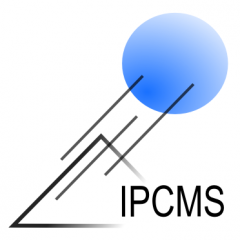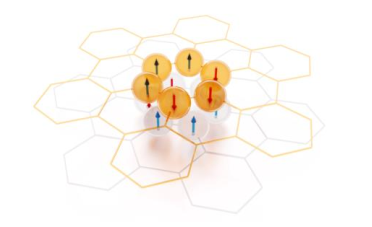Speaker: Melanie Muller, Fritz Haber Institue, Max Planck Society, Berlin, DE
Séminaire Axe 1 présenté par Mattia Udina
Orateur : Mattia Udina, La Sapienza Roma
Le résumé est disponible Ici.
Séminaire DCMI – Axe 5 présenté par Kévin DEDECKER
Kevin Dedecker (Institut Européen des Membranes (IEM); CNRS, ENSCM, Univ Montpellier)
Séminaire Axe 3 présenté par Dr. Maurizio Mastropasqua Talamo
Dr. Maurizio Mastropasqua Talamo (Laboratoire Moltech-Anjou, Université d’Angers)
Résumé :
Starting from initial purposes of molecular recognition, the study of chiral pi-conjugated molecules and supramolecular assemblies have led over time to a deeper understanding of chirality-related properties which do not only rely upon geometric pairing but also involve polarization in light-matter interaction and spin selectivity in charge transport. These new properties have boosted the interest in the development of chiral organic semiconductors for advanced optoelectronics applications.
Many asymmetric synthetic techniques which are particularly important in the field of pharmaceutical synthesis, can enable the practical modification of pi-conjugated scaffolds with various stereogenic motifs, resulting in molecular semiconductors and chromophores showcasing diverse chirality-related properties.
Some examples of asymmetric modification of molecular semiconductors and chromophores will be given in this lecture along with a discussion about chirality-related properties observed within the newly synthesized materials.
Séminaire Axe 3 présenté par Dr. Ludovic Favereau
Dr. Ludovic Favereau (ISCR, Université de Rennes)
Séminaire DMONS – Axe 1 présenté par Horacio Miguel PASTAWSKI
Horacio Miguel PASTAWSKI (Instituto de Física Enrique Gaviola, Universidad Nacional de Córdoba-CONICET, Academia Nacional de Ciencias-Argentina)
Résumé :
I will describe the qualitative features of our three-decade long experimental and theoretical quest to
identify emergent phenomena within the quantum dynamics of spin and charge excitations. A quantum
phase transition occurs as an analytical discontinuity of a physical observable, as illustrated by the
Anderson metal-insulator transition in disordered systems. We observed a clear phase transition in the
case of two interacting nuclear spins undergoing Rabi oscillations in presence of a spin environment [1],
that, according to the Fermi Golden Rule, results in an imaginary energy in a 2×2 non-Hermitian effective
Hamiltonian [2]. The oscillations became a purely exponential decay when their coupling strength fell
below a critical value. Our first experimental hint that many-body interactions could lead to irreversible
dynamics, appeared when confronting the insurmountable limitations in performing a perfect time-
reversal procedure, even in a fairly well-controlled setting of nuclear spins [3]. After a decade of work,
we experimentally observed [4] a phase transition to an intrinsically irreversible regime in the
thermodynamic limit. However, its analytical proof has initially eluded us [5]. Recently, we observed a
striking universal stability of coherently diffusive one-dimensional systems with respect to decoherence
[6]. This approach gives a new insight to the “poised realm” hypothesis, promoted for biological systems,
stating that the edge of chaos is a favorable condition to charge and excitonic transport. As pointed out
by R. Laughlin, classical chaos can lead to diffusion, and hence, to a form of quantum dynamics extremely
robust against environmental noise.
[1] Environmentally induced quantum dynamical phase transition in a spin swapping operation, G.A. Álvarez, E.P.Danieli,
P.R.Levstein, and H.M. Pastawski,J. Chem. Phys. 124, 1 (2006);
[2] Revisiting the Fermi Golden Rule: Quantum dynamical phase transition as a paradigm shift H. M. Pastawski Physica B 398,
278 (2007);
[3] Attenuation of polarization echoes in NMR: A test for the emergence of Dynamical Irreversibility in Many-Body Quantum
Systems. P.R. Levstein, G. Usaj, H.M. Pastawski, J. Chem. Phys. 108, 2718 (1998);
[4] Perturbation-independent decay of the Loschmidt echo in a many-spin system studied through scaled dipolar dynamics. C.M.
Sánchez, A.K. Chattah, K.X. Wei, L. Buljubasich, P. Cappellaro, and H.M. Pastawski, Phys. Rev. Lett. 124, 030601 (2020);
[5] Loschmidt echo in many-spin systems: a quest for intrinsic decoherence and emergent irreversibility P. R. Zangara and H. M.
Pastawski, Phys. Scr. 92, 033001(2017);
[6] Universal stability of coherently diffusive 1D systems with respect to decoherence. F.S. Lozano-Negro, E. Alvarez Navarro,
N.C. Chávez, F. Mattiotti, F. Borgonovi, H.M. Pastawski, G.L.Celardo, arXiv.2307.05656.
Pour tout contact : Rodolfo JALABERT : rodolfo.jalabert@ipcms.unistra.fr
Séminaire DMONS/DSI – Axe 1 : présenté par Anna Galler
Anna GALLER / Institute of Theoretical and Computational Physics, Graz University of Technology, Austria
Résumé : Optical phenomena in solids are fascinating and of great importance for technological applications. In this talk, I will first present a novel approach to compute the optical response and color of new inorganic pigment materials from first principles. I will show that the brilliant colors of my target materials, certain transition-metal oxides and rare-earth semiconductors, are strongly influenced by the presence of transition-metal and rare-earth electronic states, whose theoretical treatment requires elaborate many-body techniques.
The second part of the seminar will be focused on nonlinear optical phenomena. I will investigate the response of monolayer hexagonal boron nitride, a prototypical 2D semiconductor, to intense ultrafast laser pulses. I will show that the conduction band charge occupation induced by an elliptically polarized laser can be understood in a multi-photon resonant picture, but remarkably, only if using the Floquet light-dressed states instead of the undressed matter states.
[1] Ransmayr, Tomczak and Galler, PRM 6, 105003 (2022)
[2] Galler, Rubio and Neufeld, J. Phys. Chem. Lett. 14, 50, 11298–11304 (2023)
Pour tout contact : Mébarek ALOUANI : mebarek.alouani@ipcms.unistra.fr
Séminaire DON/Axe 4 présenté par : Simon Lenne
Orateur : Simon Lenne (Magnetism and spintronics group, CRANN, Trinity College Dublin, Dublin, Ireland)
Résumé : There is growing interest in discovering new materials with strong spin-orbit torque (SOT), leading to the study of a wider range of magnetic materials. The harmonic Hall method is a commonly used technique for SOT measurement. However, this method is unable to distinguish between the Nernst effect and SOT. To address this, I developed an extension of the harmonic Hall method which allows for the accurate separation of Nernst and SOT effects. By simultaneously recording and analysing both the longitudinal and transverse signals, this method enables clear and precise separation of the SOT and the anomalous Nernst signals. Furthermore, the numerical implementation of this method enables the study of samples with a more complex anisotropy, such as Mn2RuGa. This approach allows for efficient measurement of SOT, even when signals are small or dominated by the Nernst effect. As a result, a greater diversity of potential materials can be analysed with accuracy.
Contact: Jean Besbas: jean.besbas@ipcms.unistra.fr
Séminaire Axe 3 présenté par Dr. Thijs Stuyver
Orateur : Dr. Thijs Stuyver (Chimie ParisTech, PSL)
Résumé :
Machine learning (ML) has had a significant impact on various subfields of science in recent years. Part of the reason for the success of ML is that it enables the generation of predictive models with only limited domain knowledge: usually, only minor modifications to a generic ML algorithm needs to be made to generate effective models for a specific application. That is of course under the condition that sufficient data is available, and then we usually mean hundreds of thousands or even millions of datapoints. In chemistry, there are several predictive tasks for which we have this abundancy of data, but for most specialized applications – particularly those related to chemical reactivity – we do not have this luxury.
In principle, computational chemistry offers a way out when limited experimental data is available, since it enables data generation in a cheap and easy-to-automate manner. In the first part of my talk, I will explore this approach in a bit more detail and focus specifically on an ML accelerated computational workflow to screen for promising bioorthogonal click reactions that I recently developed.
While quantum chemical simulations of reactivity tend to be relatively cheap compared to experimental characterizations, the cost of generating sufficient training data for a machine learning model still becomes prohibitive, fast. As such, in the second part of my talk I will discuss strategies to improve the data efficiency of ML-based computational workflows for reactivity prediction. Specifically, I will focus on models based on intermediate valence bond inspired representations, and demonstrate that these outperform conventional machine learning models by a wide margin for hydrogen atom transfer reactions in the low data regime.
References
- Casetti, N.; Alfonso-Ramos, J. E.; Coley, C. W.*; Stuyver, T.*, Combining Molecular Modeling and Machine learning for accelerated reaction screening and discovery, Chem. Eur. J. 2023, e202301957.
- Stuyver, T.*; Jorner, K.; Coley, C. W.*, Reaction profiles for quantum chemistry-computed [3+2] cycloaddition reactions, Sci. Data 2023, 10, 66.
- Stuyver, T.*; Coley, C. W.*, Machine learning‐guided computational screening of new candidate reactions with high bioorthogonal click potential, Chem. Eur. J. 2023, e202300387.
- Alfonso-Ramos, J.; Neeser, R.; Stuyver, T. Repurposing Quantum Chemical Descriptor Datasets for on-the-Fly Generation of Informative Reaction Representations: Application to Hydrogen Atom Transfer Reactions, ChemRxiv 2023, 10.26434/chemrxiv-2023-2n281.
Séminaire AXE 1 “Sciences et Matériaux Quantiques” : présenté par Vikram Deshpande
Orateur : Vikram Deshpande, University of Utah, USA
Résumé : Topological materials have burgeoned of late due to their implications for the fields of electronics, spintronics and quantum computing, among others. While their electronic properties are important in their own right, they can also couple in fascinating ways to the lattice. We have developed techniques to deform materials controllably and study their resulting electronic properties in-situ, while complementarily sensing the electronic ground state through the mechanical degree of freedom. In this talk, by way of introduction, I will first present purely electrical measurements on the prototypical topological material, the three-dimensional (3D) topological insulator (TI), wherein we hybridize Dirac cones of 3D TI surfaces controllably to realize the quantum spin Hall effect in the ultrathin limit. Then I will present our recent results applying the above-mentioned mechanical techniques to two different topological materials, namely twisted bilayer graphene (TBG) and the intrinsic magnetic topological insulator (MTI) MnBi2Te4, respectively. We are able to tune the Hofstadter’s spectrum of non-magic angle TBG and induce magnetism in non-magnetic correlated insulating states of magic-angle TBG using isotropic strain, for example, and detect various magnetic states and measure magnetoelastic couplings in the case of MTIs. Our advances present unique routes to tuning and sensing the parameter space of these exciting materials.
Contact : Stéphane BERCIAUD (berciaud@unistra.fr)

